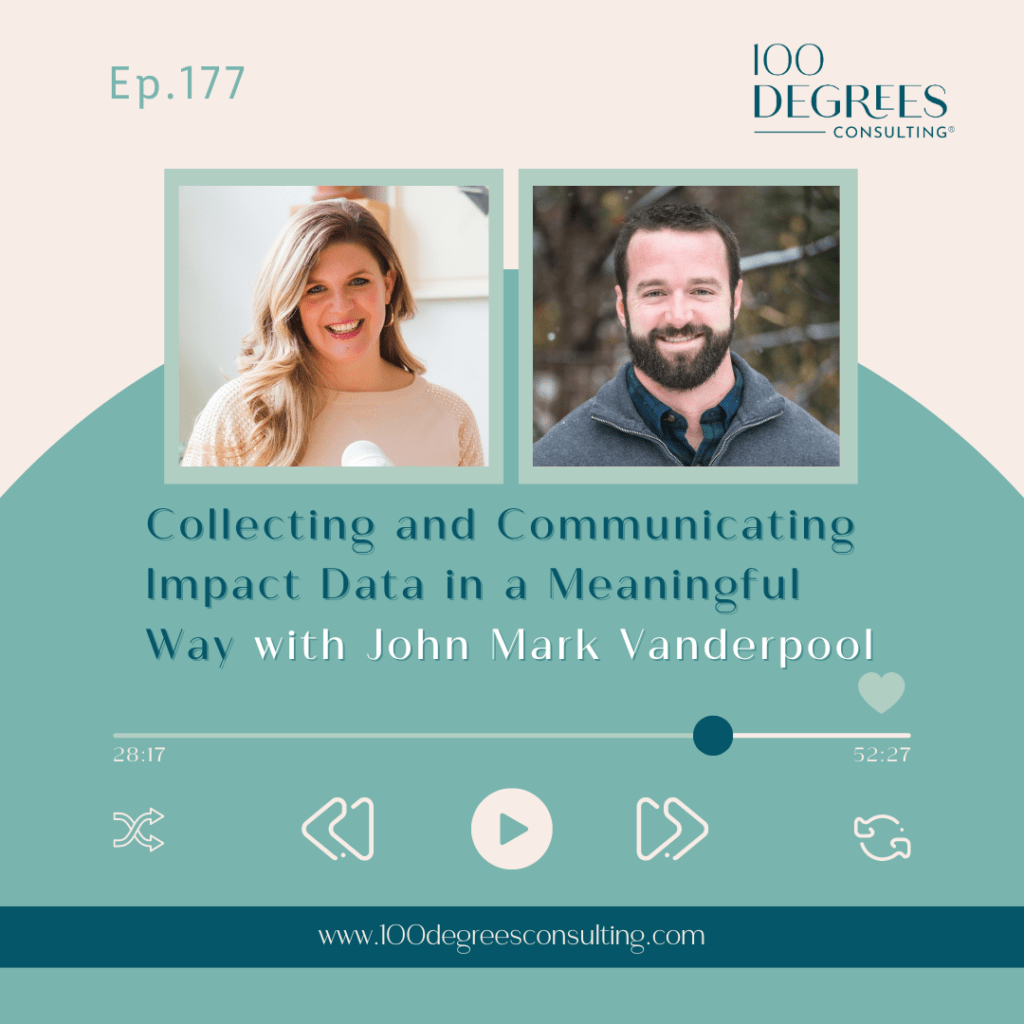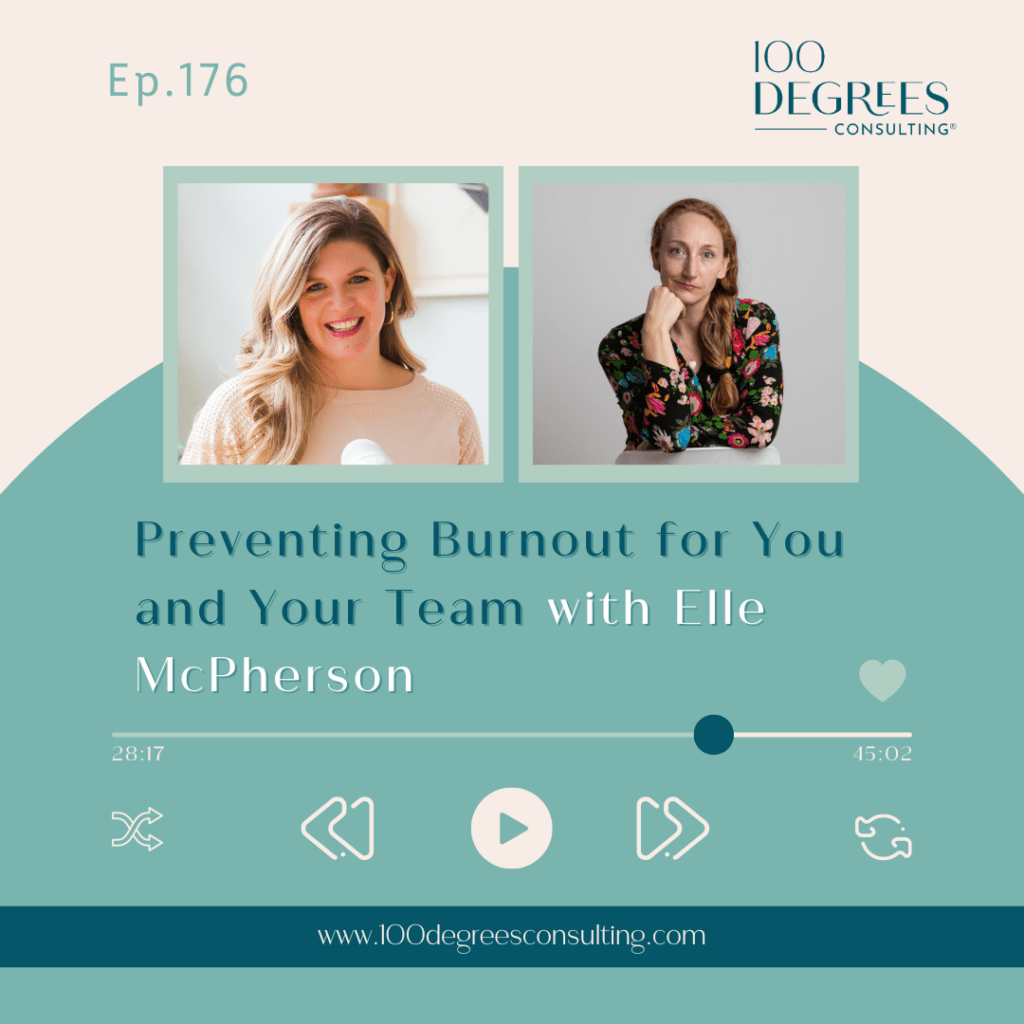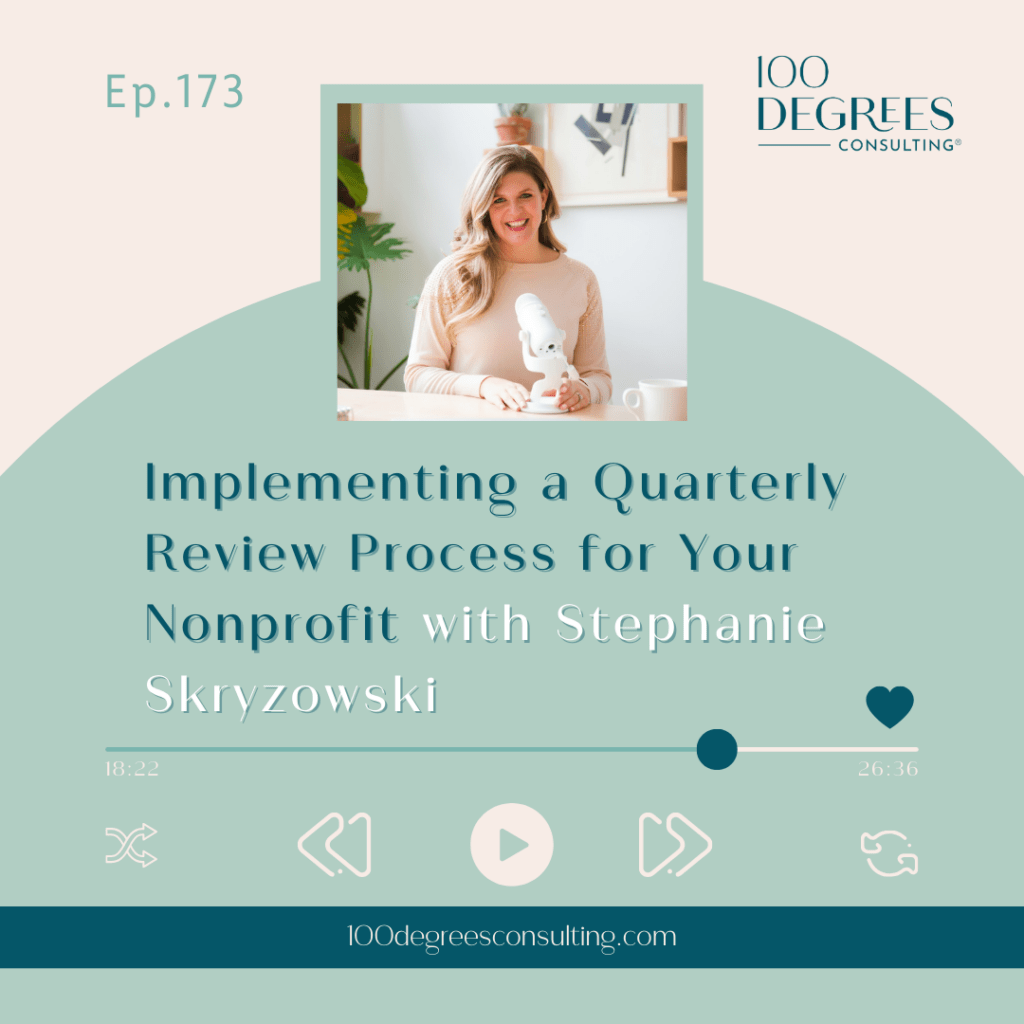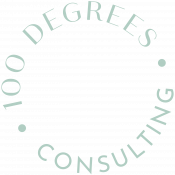Transcript Episode 128 – Building a Diverse Leadership Team with Jailan Adly on The Prosperous Nonprofit
Stephanie Skryzowski: [00:00:00] Welcome to the prosperous nonprofit, the podcast for leaders who are building financially sustainable and impactful nonprofits and changing the world. I’m Stephanie s Kowski, a chief financial Officer and founder, and c e o of 100 Degrees Consulting. My personal mission is to empower leaders to better understand their numbers, to grow their impact and their income.
On this show, we talk to people who are leading the nonprofit sector in new, innovative, disruptive, and entrepreneurial ways, creating organizations that fuel their lives, their hearts, and their communities. Let’s dive in.
Hello. Welcome back to the Prosperous Nonprofit. Y’all know me. I am Stephanie Razowsky, and today I have with me Jaylon Adley. Jaylon is a seasoned social impact executive and strategist with experience [00:01:00] navigating organizations through pivotal transitions and periods of. Growth. She leads good citizens East Coast Hub and supports the organization’s business development and strategic initiatives.
She joined Good Citizen to help social sector organization to find extraordinary leaders to move the needle forward on complex challenges. So in other words, Jaylon works with a nonprofit sector to place leaders in leadership roles in nonprofit organizations. And so, We had a fantastic conversation today about the importance in investing in the right leaders in your organization and really navigating some of the challenges that we are seeing as nonprofit leaders right now and being able to find and retain really good staff.
So we talk a little bit about diverse recruiting strategies, and she shares some gems about really having strong. Donor partners or investors to really invest in these leadership roles in your [00:02:00] organization and so, so it’s a fantastic conversation. If you have any questions or if you have had any challenges lately with staffing your organization with people, this is a episode to listen to.
Jaylon is a wealth of knowledge and. Comes from a long, long time experience working in the nonprofit sector and really forging partnerships between diverse stakeholders from the private, public, and social sectors to build the capacity of impact driven initiatives, individuals and organizations. So she’s got the strategy, she’s got the experience, and now she is working to staff nonprofit organizations with the leaders that they need to have the impact.
That they wanna have. So without further ado, let’s go talk to Jaylon.
Hey everybody. Welcome back to the prosperous nonprofit. I am excited to be here today with somebody that I have known for many years at this point. Jaylon Adley Jaylon. Welcome. [00:03:00] Thanks Stephanie. It’s great to be here. So tell us a little bit about your role and what you do
Jailan Adly: now. Yeah, so I’m a managing director at Good Citizen.
We are an executive search firm that specializes in the social sector, so we help nonprofits and foundations and social enterprises with their leadership searches. Um, usually be ping up. So
Stephanie Skryzowski: you really have a pretty broad sense of the nonprofit sector because if you’re the one that is finding the top talent and the leaders of these organizations, you see a lot I would imagine.
So what do you see like sort of happening broadly in the nonprofit sector right now? What challenges are organizations that you’re working with? What are they facing?
Jailan Adly: Yeah, I think we’re kind of living in a, you know, the, the post covid 2020 world where we’re seeing a lot of different organizations [00:04:00] face similar challenges.
So you know, everything from. Really grappling with the work from home and how that has manifested into, you know, what the expectations are, even from candidates nowadays. And I think, yeah, a lot of, you know, nonprofits and foundations are really struggling to figure out what, what is that right balance, right?
We know that top talent is really looking for that flexibility, but a lot of times, especially, you know, those organizations that their work is very place-based. There’s a sense of, you know, wanting staff to be in the place that they’re doing the work. So we’re working a lot with organizations to help them think through that as they look to, you know, build out their leadership teams in a way that that also, you know, sets an expectation that makes sense for the entire organization as well.
So that’s kind of one of the things that we’re, that we’re looking at. And you know, I think also the, for us based and, and also globally the kind of social reckoning [00:05:00] that we went through in 2020 and post that we’re seeing, you know, a lot of organizations come and say, we need to work on our diversity, equity, inclusion.
Um, but they’re starting from very different starting lines. And so, you know, really working with organizations and boards to understand where they’re at. What does it mean to build a diverse team, and then what are the right steps to do that? Right. I think there’s a, a tendency to kind of fast forward to, well, if we just hire diverse candidates, we’ll be okay.
But if the organizations don’t actually do the work, oftentimes they’re setting candidates of color up for failure, right? It, it’s not an environment where it’s necessarily psychologically safe. It’s not an environment where they can move things forward. So there’s a lot of kind of background work that needs to happen.
I. Uh, that isn’t just about, you know, making sure that your leadership teams are diverse and your staff is diverse, but actually making sure that the, the scaffolding is [00:06:00] there to set those leaders up for
Stephanie Skryzowski: success. I think that is, that’s really powerful. So do you and your team, are you sort of helping an organization assess where they are?
Because often like I’m, I’m sure it’s like, okay, yeah, we want diverse candidates, but like you said, if the organization doesn’t have the right infrastructure in place, that candidate is not going to be successful in their role because, Possibly it’s not safe. So are you helping sort of like assess where they are and maybe pointing them in the direction of resources for them to continue doing that work to set up a safe environment?
Jailan Adly: Yes, I mean, we’re mostly focused on the search. In that process, we do what we call kind of our, our backgrounding interviews, right? Where we’re meeting with different staff. We’re kind of doing a 360 of that role. Um, and in those discussions we’re kind of level setting where the organization is at at times.
If it does sound like [00:07:00] they might need a, a little bit more, we’ll, kind of, you know, Provide strong recommendations for them to do some more work. Go find a consultant that can support on that. Um, sometimes they come to us in their mid-process and you know, they still need to find that, that leader. So our role is to be kind of as transparent and as supportive as possible, both to the clients and the candidates, right?
We wanna be transparent with candidates. We want candidates to know what they’re walking into. Some candidates are like, I, you know, I’m, I’m ready to take that on. I understand that I’ll be, you know, the first coming in, that’s a person of color, and I’ll have to kind of do these. And there’s so folks who are ready for that.
There’s others that are like, you know what, I’m tired. Like, that’s not what I wanna walk into. So we want to have a really realistic view and be, you know, realistic with the client in terms of, here’s how the market is going to take this in. Here’s how potential candidates will perceive where you’re at in your journey.
[00:08:00] Here’s how it’s going to land with potential candidates of color. And then at the same time, you know, while yes, the clients are the organizations, we wanna make sure at the end of the day everyone’s set up for success. So we try to be, you know, as transparent as possible with the candidates to let them know like where we feel the organization is at, and then their journey.So then they can decide, yes, that’s a place where I’m able to kind of come in and I have the energy for it or, You know, no, I don’t have the energy for that. You know, I’m, I’m looking forward to the organization a different juncture in their journey.
Stephanie Skryzowski: Mm-hmm. I think that 360, that sort of 360 review you mentioned is so powerful because, I mean, you know, it’s in everyone’s best interest to make sure that everyone is set up for success.
And so I think that doing that work on the front end is going to help that end game. One thing that I have seen is, A real challenge around finding and retaining talent when resources are [00:09:00] so tight and when in a lot of cases, I know you’re, you’re recruiting mostly on the leadership side of things, but when many.
Staff members in organizations are not paid a living wage. Um, and so, you know, you’re, you’re probably at the, you know, at the higher end of things because you are recruiting for leaders. But what have you seen in terms of salaries and the discrepancy between what candidates, you know, what their value is and what they really should be paid versus what an organization has the budget for, has the resources for it, and or is willing to pay?
Jailan Adly: Yeah, I think this is the big social sector conundrum. Right? And I think it leads to the larger question of the financing even of nonprofits. As someone who came from the nonprofit sector, always knowing that foundation salaries were higher. Now, seeing that right on the, because we’re working with [00:10:00] foundations and nonprofits, there’s a massive discrepancy there oftentimes.
So, you know, I think there’s a, a conversation and a discussion that needs to be had sector-wide, right? Where the folks who are arguably dealing with the most stress, ’cause they’re on the ground doing the work, are yet nowhere near as paid as those deciding who gets the funding because of where the money is held in.
I think we’re seeing conversations in a push for more unrestricted funded. For funding that, you know, I think, you know, back in the day it was, we’re only covering programs and we’re not, you know, covering staff, which you would never hear of in the private sector, right? You can’t, you can’t create a product if you don’t have staff.
Just like you can’t run programs, if you don’t have staff, and if you want programs that are actually going to create real impact, which means breaking cycles of dependency and breaking these systemic barriers, you’re [00:11:00] going to want your top talent and your top talent. Needs to be paid, what they would get in any other sector.
And so, and I think also, you know, as we’re seeing the flex of, of skills and, and the transferability between the private sector and the social sector and the public sector, people aren’t necessarily getting pigeonholes. So, you know, the, the private sector can come and, and offer them a lot more benefits and a lot more salary for their own families.
And I think especially when we’re talking about. Candidates of color who are not just trying to create wealth for themselves, but generational wealth because they don’t have that coming in, right? And so they’re trying to set up their families for success. Those are actually really important things that they have to consider.
Yes, they want to do it for our community. Yes, we all want to do that, but at the same time, there’s all these other things that they have to factor in including, you know, their, their living and their families. And so, and it’s a candidate market right now, just, you know, there’s a, there’s been a push for that and so, Salary has been a [00:12:00] real sticking point for organizations that aren’t necessarily able to, to come up to where the rest of the market is or meet the rest of the market.
So we’re seeing some come up and, and some kind of trying to stay and, and that’s caused some, some tensions in terms of the, the quality and the types of can, that can get, frankly, that, that the diversity of the pool that they can get as well.
Stephanie Skryzowski: I mean, I’ve seen this in so many organizations, even in, you know, my own organization and it’s just seeming like now the flexibility piece and the cause is like not enough anymore.
It’s, you know, you need that sort of trifecta between like, My work life flexibility and the purpose that caused the mission and the money like it used to be. I feel like it used to be where, um, you know, the cause and the flexibility was enough and oh, we could kind of get by with paying significantly lower, but like that’s not enough anymore.
And I think that’s [00:13:00] interesting your point about. How there’s more fluidity between the corporate sector and the nonprofit sector, and so people can kind of shift between and like we just can’t compete with. Corporate salaries and corporate benefits. And I was actually just on an interview right before this with a foundation employee and he is really a champion of unrestricted funding of, you know, providing organizations the infrastructure and capacity building support that they need.
But I think that’s like a little bit of an anomaly. Like he’s a unicorn and I just am not seeing that a lot. So. Yeah, I think that’s a huge challenge. So those organizations that you’re working with that are winning, that are able to provide a safe and successful environment for their new leaders coming in, what are they doing differently?
Like what? What’s working? [00:14:00]
Jailan Adly: Yeah. That’s a great question and I don’t, I don’t know if there’s a silver bullet answer. I think having really strong. Donors who are partners is really important because they’re like investors, right? And I think I’ve always talked about donors as investors because I think it’s the, it’s the same that you would in the private sector, right?
An investor wants your business to succeed. An investor wants your organization to succeed, right? And so if we kind of flip that script and think of them as investors, and they think of themselves as that they’re going to be there through prof patches, right? When Covid hits. Organizations with really strong relationships with donors, were able to go and say, Hey, we need resources to kind of get us through this.
So I think those strong relationships are key and then a really balanced, I think the, you know, the board of directors plays a really interesting function in the nonprofit world because [00:15:00] everybody’s a volunteer and there’s not necessarily monetary incentive. So you’re asking people to put in a lot of effort and they’re not getting necessarily paid for it.
And then there’s the, the other issue of, you know, they’re also usually wanting to, or being asked to donate, right? So you’re actually giving money and you’re volunteering your time, right? So it’s, it’s this interesting dynamic where then, you know, sometimes you’re creating a board that’s a fully fundraising board, but they.
Aren’t necessarily from the sector, understand the the situation at hands, or sometimes you have heavy working board where they all come from the sector, but they don’t necessarily have the funds to give to you. And if any of those get lopsided, it can get really hard for the leaders of the organization, especially the ED or the c e O to kind of move things forward.
And so really creating a balanced board where you have all those perspectives represented. And there’s a [00:16:00] real kind of, you know, working relationship between not just the c e O and the board. ’cause oftentimes there’s like gatekeeping that happens. The board really needs to understand what’s going on at the organization at large, especially if you’d have, you know, c e o founders that have been there for a long time.
Oftentimes we’re coming and, you know, it’s time to place a new c e o and it’s a founder transition. And the founder’s been around for, you know, 15, 25 years, and you know, the staff don’t feel that the board has a real pulse at all as to what’s going on. And, and you’ll talk to the staff and the board in terms of, you know, what do they think they need in a leader.
And it’s completely different. And so it’s the boards who have a pulse further than just. C e o or the ED who make the time to understand, you know, the work, meet with the staff and keep that grounded are the ones who are able to then be ready to do one of the most important things that a board [00:17:00] does, which is hire an ED or a C E O for an organization.
Right? They are responsible for that in the same way that they, that fiduciary responsibility, but if they’re just kind of tuning in when it’s time to bring that person on. Then it’s really hard to actually place someone that the staff is going to have be bought into and excited about.
Stephanie Skryzowski: That’s such a great point because I’ve seen organizations where, you know, the c e O is the only person that has a relationship with the board, and it’s almost like forbidden to even talk to them.
Not in like a, you know, Like hiding things. But it was just like, these people are like the almighty, powerful board. Do not talk to them. Do not bother them. Like they’re my thing. And then I’ve seen other organizations where, you know, each leader of each department presents to the board and there’s a relationship and there’s conversations.
And so the board is so much more informed. And I would imagine, like you said, like. The quality of leaders that the board can hire when they [00:18:00] understand what the organization actually truly needs is like, I would imagine that’s a, that’s a big difference. One thing I’ve been thinking about and kind of talking about and working on lately is thinking about the C F O of an organization and the relationship that the C F O and the C E O have together.
And so I wonder, have you done any projects working on recruiting for CFOs of organizations lately? And what qualities are you looking for in A C F O these
Jailan Adly: days? Yeah, so I think C F O roles are, are interesting, right? Because. There are some very specific nuances that, you know, nonprofit finances as, as you know, when, when we worked together it was ’cause you had that nuance, right?
You understood the unrestricted versus restricted funds. I’m like coming from the private sector, we’ll kinda look at that scratch, be like, what? What are we talking about? But all of those things are, they’re nuanced in [00:19:00] that someone who’s been a C F O at a nonprofit will be able to slide in fairly easy, however.
Principles, you know, are fairly transferrable where you could potentially get a C F O from the private sector or the public sector. I think the C F O role is actually one of the harder ones to do if the salary doesn’t match the rest of the market because they’re super transferrable skills. And so if you can be a C F O, the nonprofit, you can jump to the private sector.
So that’s one of the rules where if that salary isn’t right sized, it’s really hard to find a top-notch C f O that’ll stay for a long time. Right. And that doesn’t get poached to go somewhere else. And I think that’s one of the roles you wanna keep longevity with, right? They really wanna be a partner to the c e o because it isn’t just about, you know, balancing the books and making sure that, you know, everything is, is accounted for.
As a nonprofit where finances and [00:20:00] resources are somewhat scarce, you want a C F O who’s also strategic who can start to think about, you know, as you and your program team start to think of what are income generating opportunities we can do? What are other ways that we can generate income outside of just, you know, donations or grants, or we’re putting in this giant proposal for the US government.
We have to meet all of these compliance requirements. You know, are we here? You really need a partner in that C F O who can think larger than the numbers and think towards the future and help you put that plan in place. And so, you know, out of all the positions to, there’s kind of three positions to really invest in.
Where we find that organizations that. Invest the salary, the benefits, the support systems in those roles, and get your kind of strong trifecta, which is obviously the C E O ed. The C F O, and then your chief development officer who’s bringing in the fuzz. [00:21:00] Who in the private sector be your salesperson, right?
And your salesperson’s usually your top build person in the private sector, for some reason they’re not in the nonprofit sector and they’re the fastest to burnout and the fastest to turn over. So we really see, you know, those three critical roles, organizations who understand the value of those three roles and create the profile and the, and the jobs descriptions for that in a way that matches that are really the ones that
Stephanie Skryzowski: succeed.
Yeah, you’re totally right. It’s thinking about like the chief development person. I do feel like there is so much pressure put on that role. It’s like, okay, welcome to this new organization by the way, now you need to raise $10 million. Good luck is, you know, it’s a lot. Oh my gosh, it’s so much.
This series is sponsored by Blackbaud, the essential software provider for the organizations and people who change the world. Blackbaud has been working with finance professionals at [00:22:00] non-profit and social good organizations for almost 40 years with its Blackbaud Financial Edge, N X T Fund, accounting software expertise and services.
You can streamline your financial operations, strengthen your accountability, and make data-driven decisions to increase your impact. To learn more, visit blackbaud.com
as you’re bringing in each of these three key roles, and I think I would agree with you that those are the most critical and the ones where you don’t want somebody to pop in for a year and then have to, you know, and then leave and have to fill that role again. How do you see like those three roles working together and as you are looking to fill those positions, how are you assessing like how a leadership team of those three roles and maybe some others, like interact with each other?
Because I have seen, I’m asking because I’ve seen the C F O role and the development, like the head development person or that lead fundraising person, [00:23:00] um, really operate in silos and that. Obviously it doesn’t really work very well. You need each other, but then I’ve seen other organizations having it work really well where they’re working so closely together.
So how are you sort of assessing and, and helping set that relationship up for success? Yeah,
Jailan Adly: that’s a great question. I mean, in our role as a search firm, we’re trying to find. The right candidate based on not just qualifications we need, but the team. So oftentimes we’re looking for one role, and we now have met the other folks that are on the senior leadership team in those 360 interviews that we do.
So we get a sense of, you know, what are the skills already on the team? What are the different personalities? What are the leadership styles? Some of the questions we ask is, what’s actually missing from your leadership team, right? From a leadership style perspective. So not just kind of the skillset, but kind of the thinking.
Right? Sometimes we’ll get, you know, answers like, we’ve got a lot of doers that we’re missing the visionary, or we have a [00:24:00] bunch of visionaries. We actually need someone who’s gonna, you know, come in and like, help us drive forward. So it, it’s kind of, you know, we have to work within the confines of the search that we’re working on, but part of the, you know, bringing a diverse pool forward.
We like to, as much as possible, not just bring diversity from the perspective of, you know, who those candidates are and, and their lived experience and all of that, but also their styles so that they get a chance to kind of see different scenarios, right? Like, what would this style bring to our leadership team versus this one?
And, and, you know, what’s complimentary? What will push us, what will, you know, all of those types of questions. And then, As the client starts to narrow down from that pool to the person that they select, helping kind of guide and advise and remind, right. So that they’re kind of thinking of those things.
Right. So as they’re kind of, as we’re doing the debriefs, talking through, yes they have these really strong qualifications and X, Y, and Z, but you know, [00:25:00] how do you think that Will will be from a, you know, a leadership team? Do you feel like they’re going to gel well with the team? Are they. Are they filling a need that you said that you, you know, you really needed in terms of, you know, bringing that visionary perspective?
So those are the types of things that, you know, we’re constantly kind of helping guide and advise clients as we’re going through a search process.
Stephanie Skryzowski: I, I like that. Especially the part that resonated with me about like, okay, we have a bunch of visionaries. We need somebody who can actually like create a plan and see something like through the execution or vice versa.
I think that’s huge and that’s something that I. I know I’ve even looked, you know, looked for and thought about as I’ve brought people onto my team and I feel like sometimes we’re not thinking that strategically in the nonprofit sector, maybe not so much with leadership positions, but thinking about how listeners can apply this to hiring in their organization.
Yeah. Maybe you’re not hiring a c E O or executive director. Maybe you’re hiring, [00:26:00] you know, a program officer, but thinking about how their skillset and their soft skills will contribute to the team. Like I knew. I needed a sort of right hand person on my team that’s a doer that is actually going to get into the details.
’cause I’m more like, I wanna think about the ideas and I don’t really wanna get into like the details. And so I just think thinking about that I. For anybody listening, how to balance your team, even if you’re not hiring for leadership positions, but people within the organization. I would imagine that like that same idea applies, right?
Like it does. You don’t have to be just thinking about your, your leadership roles. You can use that same, that same idea and really everything you’ve said today of really making sure you’re setting, setting the person up for success and things like that when you’re recruiting anybody in the organization, not just leaders.
Yeah.
Jailan Adly: Yeah.
Stephanie Skryzowski: What type of. Technology or data related experience or qualities are [00:27:00] you looking for when you’re filling some of these leadership roles and not, not necessarily like specific software, because that would vary based on, you know, based on the role, but what sort of level of proficiency or interest even are you looking for when it comes to like using data and KPIs and that kind of thing for managing an organization?
Jailan Adly: Yeah, I think that has really depended on the level of sophistication the organization is at. We’re seeing overall a general movement towards more sophistication on the tech front and and tech front being like, you know, being able to use data, you know, being able to monitor in real time. So are we collecting data analytics in real time so that we can make real time decisions?
Different organizations are at very different places in their journey as to, you know, where, where they are. But the, the trend is moving towards more technologically [00:28:00] advanced on that front. And so in terms of what we’re looking for, really, again, depends on where that organization is. Some of the organizations we work with are very tech forward, and so, you know, those are skills that are.
Kind of, you know, non-negotiable. And then there’s other organizations where it’s a nice to have. And so, you know, one of the things that we do when we’re getting ready to launch a search is we create kind of a, a custom assessment, right? Rubric where it’s, where we kind of outline here are the skills in the background we’re looking for what’s negotiable, what’s a nice to have.
I think oftentimes, you know, organizations go into, we all do this, right? We’re kind of trying to find a unicorn. Well, Sometimes they’re out there, sometimes they’re not. And so we wanna kind of understand like what are the priorities that we’re looking for? And then kind of go from there. Ideally, this person has all of the qualifications we’re looking for, but if they’re area of genius, right?
Is it a few? Making sure that area of genius in what is needed is the part that overlaps the most in that kind of Venn
Stephanie Skryzowski: diagram. [00:29:00] Yeah, definitely. That makes sense. And I’ve worked with some organizations who, like everything that they own is in an Excel spreadsheet and others who are using much more sophisticated ways to capture it and measure their data.
But I know from like the finance side of things, we are trying to bring more KPIs and more financial metrics to our clients so that. They can use that information to help them measure where they are, where they wanna be and their, their goals and whatnot. Alright, so I think I have just two more questions for you.
My first is, what advice would you give to job seekers in the nonprofit sector right now? Ooh, that’s a great question. Very broad question.
Jailan Adly: You know, the advice I would give candidates in the non-profit sector and, and frankly, you know, in any sector is. Get really clear on not just the issue areas you wanna work in, but the function area that you [00:30:00] wanna work in as well.
Right? Do you wanna like lean in and going into development? Right? What does that mean to be the fundraiser? There’s different branches you can go. You can be a major gifts officer. You can be a proposal writer. Um, do you wanna go into the finance or the operations and the program side, there’s a whole plethora of things that you can go into on the program side if you want to, you know, if you’re on the foundation or you wanna transition in the foundation world, being able to bring that, you know, showcase your analytical skills, your ability to research, your ability to see big partnerships and big systems, and bring that together and then articulate that in your resume.
There’s a debate out there about cover letters. We’re still trying to find the best thing. You know, especially with chat G p T out there. You know, cover letters are kind of easy to write, but taking the time to really make sure that you are providing the selection committee, the recruiter, the hiring manager, enough of an insight from whatever you [00:31:00] want to call that, that top page, right, that makes something more personalized, jump out from just your resume.
You want your resume to be pretty crisp and clear and succinct. Then you know, your value statement, your mission statement, your cover letter, whatever that is, to really kind of jump out on the personal side and link to the position description. So really read your position, whatever you’re applying to.
We get this all the time where we’re clear as to like what the characteristics are, and then we’ll get someone just, you know, coming out from left field. Hasn’t tied. They might see it in, in their mind that there’s a translation there, but they haven’t done the work of like tying that in the application.
So really going through and saying, okay, I hear and I’m seeing that this is what you’re looking for. Here’s what I have done, demonstrates that I can do X, Y, and Z. That tie is what’s gonna bring you
Stephanie Skryzowski: to the top. I think that’s so powerful, and I totally agree, and I feel like when people [00:32:00] are doing the former where they’re just like dropping this basic cover letter that’s really not related at all.
It’s like they’re doing the, you know, the spray and pray method where it’s like, let’s just apply to everything and hopes somebody like grabs me. But I feel like being much more strategic in your search and actually putting some time into the positions that are really and truly a good fit, like. I feel like it’s more than just a numbers game, like, and I feel like people are kind of treating it like a numbers game, but like, if you’re more strategic and focused on your search, you’re, you’re gonna win versus just applying to literally everything.
I don’t know if you agree. I feel like that’s how I’ve done it before. It’s being more strategic and focused and putting that extra time into things that I think would actually be a good fit versus trying to play a numbers game.
Jailan Adly: Absolutely. And look, look over a job is exhausting and it’s stressful and it’s tiring.
And, and we get that. You know, I think the advantage of, you know, [00:33:00] using a search firm is we are able to provide way more support to potential candidates. And granted, you know, again, we’re looking at the executive levels, right? It would be cost prohibitive to do it for every single role that you have.
Hopefully you have a team that can do some of this, but you know, as a search firm, we try to answer potential candidate questions before they apply so that we’re not necessarily wasting their time. Um, and so that they know, you know, ahead of time, you know what, this isn’t necessarily the right position.
So we, you know, we try to do that as much as possible, at least at at at citizen. That’s one of the things that we, you know, heavily focus on is, is making the time as much as we can given, you know, we’re working on, on a lot of things to potential candidates so that. They’re not wasting their time if it’s not a good fit.
Um, and also being transparent, right? When we have conversations and saying, you know, I’m not sure if this is necessarily aligned, you know, feel free to, to throw your hat in, but based on what we’re hearing from the [00:34:00] client, this might not necessarily be the, the right alignment. But yeah, for those that aren’t going through, you know, the role’s not going using a search firm, then I think being strategic and really.
You’re gonna, you’re gonna spend more time on that potential application, but that time you spend on that is gonna get you further than that same amount of time, kind of, you know, doing that spray approach, right, where you’re just kind of putting it right and no one’s gonna call you because they don’t, you haven’t made that time at all.
Stephanie Skryzowski: Yeah, that’s huge. That is huge. And are you seeing, um, it’s interesting that you mentioned chat, g p T ’cause I’ve definitely had several conversations with people in the sector about using chat G P T, like for grant proposals, for example. Is it clear to you when somebody has used an AI tool for their cover letter or not necessarily?
Jailan Adly: You could usually tell, um, but not necessarily. And, and honestly, if you’re smart about using [00:35:00] it, I mean, I, I have definitely told people check it out for grant proposal writing. It’s interesting tool to write proposals. It’s an interesting tool to write communications pieces and emails if you know how to prompt it to actually have your voice.
You know, I think if you are just feeding it something and, and it’s spit out and you’re just using that, then that has, you know, there’s no strategy there. If you’re using it to help wordsmith a little bit and like fix the sentence that you wanna make a, you know, a bigger impression with then, you know, to each their own.
Can we tell when something has just been, you know, kind of copy pasted? Yes. You can absolutely tell when something’s been copy pasted. Are there others that are probably using it, you know, in a strategic and smart way and, and we’re not noticing, yeah, most likely.
Stephanie Skryzowski: Yeah. Yeah, I agree. I mean, when I’ve asked it, I’ve definitely used it for lots of different things, just kind of testing it out and the exact text that it spits out for certain things.
I’m like, [00:36:00] yeah, I would never say anything like this, so maybe I can use the ideas and then shape it, you know, sort of shape it into my own. But, you know, using it for. An outline. I’ve definitely done that before and it’s so helpful ’cause it’s like, oh yeah, I had all these ideas, but now it’s organized it nicely for me and now I can use this to then help me write the piece or whatever.
So that’s interesting. Okay. Don’t use Che G P T and like use it word for word and just pop it into a cover letter. ’cause you’re gonna probably tell. So that’s a good tip to our listeners. All right, well my last question for you today, Jaylon, is what does a prosperous nonprofit look like to you?
Jailan Adly: So I think for me, a prosperous nonprofit is one that has its eye on the ultimate outcome of the impact.
Depending on, you know, what the goal is, if your goal is alleviating poverty or solving [00:37:00] a climate crisis, or one of those than a prosperous nonprofit. Should be actually working itself out of a job and out of cycles of dependency and having a vision to do that, right? Because as soon as you, nonprofits usually are coming from a scarcity model to be begin with, and then from that, you’re building a scarcity future, right?
And so prosperity is. Yes, the prosperous nonprofit is one that has the funding it needs to do its work, the, you know, support and the investors it needs to do at work. It’s work, it’s a joyous place to work. It’s showing that it’s making, you know, massive impact. The beneficiaries, the participants, the communities that it serves are you.
You see tangible changes there, but ultimately, if the problem really is being solved, then. [00:38:00] It should be finding a way to gracefully sunset. And those are for specific nonprofits, right? If you’re an arts nonprofit education, it’s a little bit different, but kind of, you know, the world that I come from working in global development, most of the things we were trying to solve, ideally would be solved.
Right? And we should be working ourselves out of a, out of a job. Mm-hmm.
Stephanie Skryzowski: I love that so much. ’cause that’s something I often say about my role and my company as a fractional finance team is like, we would like to work ourselves out of a job so that we’ve built capacity internally for an organization to grow to the point, to be able to hire somebody full-time internally.
And so I think from a broader perspective, I. I love that versus this, like you said, sort of cycle of dependency. And I think that there’s such vision that needs to come with that thought about working ourselves out of a job and there’s like, you know, [00:39:00] removing this, oh my gosh, there’s like so many directions we could go with this, but just thinking about like removing the, those sort of ego and the like.
I’m such a hero for like, working on this big problem and, um, removing that from the equation I think is just, yeah, that’s, again, that’s a whole other direction that we could go, but um, I, I love that definition of a prosperous nonprofit, and every single time I ask this question, I get a completely different answer from everybody.
And so I haven’t gotten that answer before, um, about sort of a prosperous nonprofit being one that’s focused on working themselves outta business.
Jailan Adly: And I, I think it ties well to what you said in that, you know, as we’re talking about proximate leadership and decolonizing philanthropy and decolonizing the nonprofit sector, That in and of itself moves away from that savior hero complex, right?
Because if [00:40:00] you are actually bringing in proximate leadership, the, the solutions that they will bring are going to be community centric and solution focused because the lens of which they’re looking at the problem doesn’t come from this. You know, I have this one great idea and it’s special and I’m the hero and I’m gonna, you know, save this.
That, that meant when you’re coming from that hero savior mentality, it is always, even in the best of intentions, setting up a dynamic where there’s a sense of, unless I am here or this entity is here, this isn’t going to work. Right. And when you shift the mindset, By shifting your leadership and bringing leadership that is proximate to the problem that has lived experience with it, it is going to be far more solutions oriented and solution centric than when you’re kind of parachuting in a solution.[00:41:00]
Um, so I think those two things kind of go hand in hand, and we’re seeing a lot of talk about leadership and decolonizing the sector. We’re seeing some action, but I would say we’re, we’re not quite there yet.
Stephanie Skryzowski: Mm-hmm. Oh my gosh. Okay. Can we record another episode all about this? Yes. And you know, I think we work in similar spaces.
Um, In terms of global development and I think we’ve, you know, probably seen some good examples of this and some not so good examples of this. And so I think it’s a conversation that needs to continue to be had and we can, we can leave it at that for today. This was incredible and I think just super enlightening to hear things from your perspective as somebody that is helping to.
You know, staff, the leaders of the nonprofit sector right now. So if organizations want to learn more about the work that [00:42:00] you do at your company, where can they find out more? Yeah,
Jailan Adly: they can visit us on our website, which is www.goodcitizen.com, and you can also follow us on LinkedIn. Both organizations that are looking for search professionals, we’re happy to speak with you and prospective candidates.
All the positions that we work for, for a variety of clients are on our website as well as our LinkedIn.
Stephanie Skryzowski: Awesome. Awesome. Good citizen.com, everybody. Definitely check that out. Well, this was such a great conversation. I really appreciate you. Thank you so much for being here, Jaylon, taking the time. I
Jailan Adly: really appreciate it.
Stephanie Skryzowski: Hey everybody. Thank you so much for listening to this week’s episode, sponsored by Blackbaud. As always, you can get all of our show notes, all of the links we mentioned over at 100 degrees consulting.com, and I want to mention something extra special. Over there, you will find the link to our brand new white paper, the Guide to Hiring a Modern C F O [00:43:00] for your nonprofit.
So this is a white paper that I wrote in partnership with Blackbaud, and you will learn. What it means to be A C F O who can help drive a nonprofit in today’s climate. What you should consider when hiring a modern C F O and red flags to look for when evaluating your next C F O. So head on over to 100 degrees consulting.com.
Grab the show notes for this episode, and we will point you in the direction of this brand new white paper, your guide to hiring a modern c f O for your nonprofit. Thanks as always for listening, my friends, and we will see you next time.




















